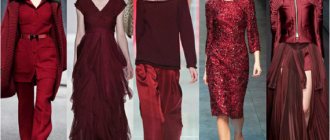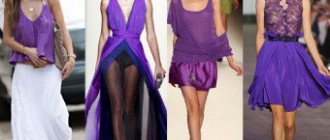Interesting facts about color perception
This theory was invented by the famous German writer Johann Goethe. The bottom line is that a dark palette has a calming effect, while a light palette has an invigorating effect. If you look at the cold spectrum, you will first notice blue, and when looking at the warm spectrum, yellow. They are the “foundation” for creating all other shades.
As mentioned above, gamma affects people both on a physiological and mental level. In the first case, the interaction should occur in a fairly short period of time, and in the second, a longer one. Perception functions through associations. First we catch it with our visual organs, and then the influence is tactile. For example, blue belongs to the cold complex.
Many scientists believe that it has a direct effect on body temperature or blood pressure. The spectrum from blue to greenish contributes to its increase, and from yellow to reddish - to its decrease.
What does green mean in psychology?
A huge amount of this tone in nature is associated with the presence of chlorophyll. This is a special pigment contained in the leaves and stems of many representatives of the flora. It allows plants to independently produce nutrients to support their vital functions: this particle is an important link in a process such as photosynthesis.
Green is obtained by combining yellow and blue, so it can be interpreted in different ways. On the one hand, it is recognized as the safest in the world. It is not for nothing that such a signal at a traffic light allows you to cross the roadway. On the other hand, it is a sign of life, harmony and tranquility. Anyone who looks at this tone will associate it with growth and development.
Characteristic
All cultures and nationalities have come to the general conclusion that it is a connotation of prosperity. This meaning in our subconscious is associated with the awakening of nature in the spring, when the snowdrifts melt and young grass appears, the leaves of the trees bloom and everything around seems to come to life. Numerous religious festivals and traditions originate from this performance.
Some believe it is the gamma of life force. She is able to replenish the lack of energy at the psycho-emotional level. Varieties with a large drop of blue have a calming effect. This cold type is often used in the treatment of phobias, such as fear of enclosed spaces. Individuals with claustrophobia suggest spending some time in a room where the walls are painted a soft greenish color. According to experiments, such an atmosphere makes it much easier to cope with the condition that arises in a closed room.
Luscher test
Color perception has been studied by many psychologists. But a significant contribution in this direction was made by Dr. Max Luscher. He was interested in how color affected the psychophysiological state of patients.
During the research, the doctor came to the conclusion that a person makes an unconscious choice of color. To check the patient's perception, he is given a simple test. You need to choose the color you like from those offered. The patient must simply show a shade that is pleasant to him. The answer should not be associated with objects, memories, or logical considerations. You need to choose one of the colors for as long as possible until the proposed set changes.
In fact, the decision made may be related to the patient’s internal state at a given time, as well as to his work activity. And after the test is passed, all that remains is to look at the results. They are presented in the form of quite interesting and detailed analysis. If a person chooses green, color psychology allows us to learn about his character.
What does the color green symbolize in psychology?
It has long been considered a symbol of happiness and joy, harmony and peace, good luck and prosperity, as well as balance and wisdom. In past eras, the hue was associated with activities such as farming and gardening.
In the Orthodox religion, the palette is known as a sign of immortality, and in Islam it is the embodiment of heaven and life. Tone is very important in Ireland. Everyone knows that this is the centerpiece of St. Patrick's Day. And the leprechaun here is always depicted in clothes made in greenery.
I have found that it has a particularly beneficial effect on people who are under stress or nervous tension. In this case, it calms the central nervous system and helps you feel in harmony with reality. But despite all the advantages, several centuries ago in some regions the shade had negative symbolism. For example, women with green eyes were a priori considered witches. He was also associated with various evil spirits: demons, merman.
Psychologist Daria Milai
Make an appointment
Associations
The main interpretation that appears in anyone’s head is the foliage of trees and flowers, berries, fruits, plants. You can often find birds, reptiles and amphibians that have a greenish color: crocodiles, frogs, parrots, organists.
Psychologists treat different shades differently. For example, light green is associated not only with greenery, but also with yellowness, so it can be interpreted in either direction. But if there is not too much green in it, then it is classified as cool in the spectrum and is credited with calming properties.
Usually this tone is considered to be more positive, including its dark varieties. Indeed, in all its manifestations it is closely connected with nature, which people see every day.
Impact on humans
As noted earlier, any gamma, one way or another, affects not only the emotional background, but even the health of individuals. Therefore, the choice of clothing and interior design must be approached with great responsibility, since all these elements will be evident every day.
In my personal consultation, I will tell you how to use shades correctly to get rid of anxiety and find peace. For now, let's look at the main aspects of this impact.
Positive effect
If we talk about lovers of greenery, they are distinguished by charm, stable psyche, perseverance, courage and truthfulness. I believe that such people tend to be objective, since they see not only the good, but also the bad. This skill allows them to look at things soberly, assess their own capabilities and the consequences of the situation. Thanks to this, their decision carries great weight, and the ability to make correct calculations makes them an authority among others.
Greenish is a sign of growth and development. This means that individuals who prefer this tone are constantly striving to learn new things and improve. Among other things, fans are characterized by stability, kindness and the ability to be compassionate.
Negative effect
But there are also negative qualities in the character of green lovers. Green color in human psychology means peace, which can lead to apathy for those who spend a long time in a room with such a palette. The absence of desires is explained by the fact that in such an atmosphere the individual makes up for the lack of energy and receives special energy support.
Face-to-face consultation
What are the features and advantages of face-to-face consultation?
Find out more
Skype consultation
What are the features and benefits of Skype consultations?
Find out more
The natural shade conceals all the secrets of the universe, and therefore endows people with secrecy. The quality is more bad than good. I use gamma for my own purposes. With its help, they cure claustrophobia by placing someone who suffers from a fear of closed spaces in a room made in greenish tones. The calming aura has a beneficial effect on the body, which helps to significantly reduce attacks.
Also, you should not resort to greens when you are overworked or nervously exhausted, as this can lead to a complete loss of energy. But in general, the effect depends on the balance of yellowness and blueness. If blue predominates, the shade will become more intense. And in the case of yellow – harmonious and invigorating.
Negative influence
Like everything in this world, the color green not only has positive characteristics, but also has negative properties. What is this negative impact that the color green can have?
The psychology of color notes that sometimes its calming effect becomes excessive. And a person who is in his “green world” becomes very withdrawn, which does not benefit him at all.
Due to this effect, green color is used in the treatment of people suffering from claustrophobia. They are placed in a closed room, the walls of which are painted in this shade. Patients' internal panic disappears and they calm down under the beneficial effects of pale green color.
However, one must be extremely careful when using this color to people suffering from depression or nervous exhaustion. In such cases, green can lead to complete loss of strength.
The effect of green on people depends on whether blue predominates in it, or whether there is more yellow in percentage terms. In the case where there is more blue color, the shade becomes colder, which means it strains the eyes more and causes general tension and wariness in a person.
At the same time, yellow gives a light atmosphere of ease.
Impact on mental state
In a general sense, green is known to be relaxing. But if we talk about varieties, for example, light green, then it can have a slight invigorating effect.
Let's look at how it affects your well-being:
- Color has a beneficial effect on the psyche. It allows you to overcome problems such as phobias, neuroses, melancholy and anxiety. This is especially important for hot-tempered individuals, as greens help to “cool them down.” And for those who feel overwhelmed and empty, it gives strength, gives a good mood, and also increases productivity and concentration.
- Individuals who spend a long time in a room where the walls are painted in a similar color scheme feel comfort and coziness. Even a small amount of green decor can improve the condition of the body.
- For people with mental illnesses and frequent mood swings, the tone allows them to get rid of negativity.
- Color therapists are confident that it reduces pain, and also stimulates the rapid treatment of infectious and inflammatory diseases, stabilizes blood pressure and heartbeat. There is a huge impact on the visual and respiratory organs, bones, muscles and gastrointestinal tract.
- It is believed that it has a beneficial effect on relationships, helping lovers to be more caring and attentive.
The relationship between color and human character
Depending on where the colors are used, a person makes a choice in favor of one, or at most two or three. Preferences may change over the course of a lifetime. This happens if you find yourself in an unfamiliar environment, in a different emotional background. In other words, your favorite color will reflect your character and communication skills.
Have you not paid attention to the fact that owners of yellow and red cars are by nature life-loving and tend to consider themselves lucky? People who are balanced in character are drawn to blue cars. Owners of white cars have a conservative view of the world, while black cars are preferred by purposeful and business people. You may not agree, but psychologists say that proud people especially pay attention to silver and gray cars.
It is not necessary to conduct a psychological test to understand individual character traits. It is enough to analyze the color scheme of clothes, things and objects that surround a person.
Red
A controversial color with an ambiguous meaning. First of all, it is a symbol of greatness and power. It has been noticed that even sports judges tend to give leadership to athletes in red clothes. In Byzantium, only patrician women were allowed to wear red shoes decorated with precious stones. Ordinary people wore black leather shoes.
A victorious color is psychologically perceived as aggressive and excites thoughts. In advertising or in road signs, it plays the role of a “master”, encouraging one to perform one or another action.
Use in advertising
Since the palette is associated with safety and freshness, it can often be found on packaging with natural and organic products. The marks “eco” or “bio” are also accompanied by this shade.
The method is used if the contents of the box contain fruits or vegetables, for example, apples, kiwis, cucumbers. The technique is also excellent for advertising medical products, and can also be seen in the logos of private clinics, pharmacies and other health-related companies.
What does green color in clothes mean?
The priority of a specific color scheme in outfits can also tell a lot about a person. After all, it is believed that through such preferences a person shares his mood, experiences, or unconsciously indicates character traits.
- Lovers of delicate greenery are characterized as easy-going and pleasant individuals to communicate with. They tend to communicate and collaborate with others.
- A bright option, especially in combination with yellow or orange, symbolizes physical activity and positivity. This complex always lifts your spirits and gives you a burst of energy for the whole day. That is why the outfit is used in order to reveal your potential.
- The meaning of dark green in psychology comes down to calm and harmony. People who prefer this type are characterized by some isolation and detachment. They love to be alone, to retire from others and immerse themselves in their own inner world.
Interesting fact: the famous empresses of the Russian Empire - Catherine de Medici and Elizaveta Petrovna - were crazy about greenery. Their choice indicates masculinity of character. In any case, absolutely everyone can afford such a wardrobe, regardless of appearance. It is suitable for both special occasions and everyday life.
Impact on the psyche
Yellow color in psychology - what it means for a woman, man, child
Green personality types tend to be meticulous. They are generous and reliable. It is important for them to receive the approval and respect of those around them. Such people have a high level of intelligence and prefer proven methods of action.
Important! Green shades are characteristic of people who quickly grasp everything on the fly and easily perceive new concepts.
In psychology, plant shades symbolize harmony, tranquility, and meditation. These colors are often used for meditation or relaxation. With their help, you can improve the functioning of the cardiovascular system.
Warm tones relieve anxiety, panic, fears, and self-doubt. They work well in positive affirmations.
Worth remembering! Green colors in color psychology do not always have a positive effect. In some cases, they lead to melancholy, loss of strength, and apathy. Therefore, individual intolerance to certain options must be taken into account.
In psychological practice, green shades are recommended for people who have experienced a difficult emotional situation. They have a beneficial effect on concentration. That's why school boards are made this color.
Dark shades do not always mean good impact. They can lead to depression and suppressed emotions. Some people like malachite stone, which has a whimsical combination of light green and rich lines.
The human psyche is a complex system. Therefore, it is impossible to say unambiguously how color therapy will work with a specific client. Experienced psychologists recommend choosing shades yourself, focusing on personal feelings.
Who chooses green?
About 15% of people prefer greenish shades. And approximately the same number have dislike for him due to superstitions. There is a connection between color taste and character. But don't take it too seriously. After all, each person is unique, so you can get to know her well only through close communication, and not with the help of generalized descriptions.
Ask a question
However, male admirers have qualities such as:
- Kindness. They are friendly, and their face is often decorated with a smile. They always try to help others, even if it is to their detriment. This is due to the fact that their level of empathy is quite high.
- Equilibrium. It is difficult to provoke such individuals to display negative emotions, since they know how to control themselves in almost any situation. Hot temper or aggression are definitely not characteristic of them.
- Perseverance and accuracy. Of course, they are far from perfectionists, but they strive for this. This manifests itself in excessive attention to detail, persistence in achieving goals and excellent productivity.
- Caring. These are excellent spouses and fathers. They strive to ensure that their loved ones are happy and do everything possible for this.
- Sociability. This trait is not as strong as those who prefer yellow or reddish, but they love good conversations.
Female representatives who love greenish shades often prioritize family rather than work. They love to expand their circle of acquaintances, have goodwill, and good health. In addition, green color in a woman’s psychology means that she:
- Patient. Like men, she knows how to control her own emotions. It is unlikely that such girls will throw tantrums and demonstrate sudden mood swings.
- Empathic. The ability to understand the feelings of others makes her provide support to people. She knows how to give excellent advice on time and find the right words.
- Intelligence. She is always smiling, respects other people and will not cause them discomfort unless there is a good reason for it.
In addition, such individuals have prudence and balance between the emotional component and reason.
Significance in psychology
Psychologists Johann Goethe and Max Lüscher, in the course of their observations, established that various shades have a close relationship with the emotional and volitional states of a person and society as a whole. As numerous studies have shown, in stressful situations, when a person experiences negative emotions, his color sensitivity to green and blue increases. And on the contrary, if a person experiences positive emotions, sensitivity to these colors decreases.
Read also: Red color in psychology
From a psychological point of view, the color green can have a calming effect on the human body, lower blood pressure, improve sleep, eliminate insomnia, anxiety and irritability. In psychotherapy and color therapy, it is often used to treat headaches and restore emotional state after severe stress.
Calm green shades in the interior of the office help improve concentration and prevent increased fatigue during prolonged mental stress.
Green color is used to combat claustrophobia - fear of enclosed spaces.
To experience the positive effects of the color green, during meditation it is recommended to imagine yourself in a green forest or clearing surrounded by fresh, bright vegetation. Green energy will gradually fill you with confidence and calmness, help you achieve mental balance and tranquility.
The psychology, emotional state, worldview and some character traits of men and women have significant differences. Therefore, the color green affects men and women differently. It also has a special emotional impact on children.
For men
Men who prefer green shades have the following character traits:
Balance - it is extremely difficult to anger such a man. He almost never gets angry and behaves with dignity in conflict situations.
Good nature is a loving, kind and understanding father and husband who will never refuse help, even if he has unfinished business.
Read also: Orange color in psychology
Sociability - compared to lovers of red and yellow shades, such a man is less talkative, and yet knows how to be the life of the party. He loves to communicate with friends and almost always evokes positive emotions in his interlocutors.
Desire to care - most men who love green are wonderful husbands and fathers. They do everything to make their loved ones feel happy.
Optimism - this quality helps a man remain balanced and calm in difficult situations. He treats any problems philosophically, and when they arise, he never falls into despair.
For women
If a woman consciously surrounds herself with green colors, it means she puts her loved ones and family first. Such a person is less scrupulous about work and career. She is distinguished by her friendliness and gentle disposition, has good physical and mental health, and prefers active activities.
Such a woman is characterized by the following character traits:
Empathy - a woman has more developed emotional intelligence compared to a man, which makes it easier for her to provide moral support to others. Many women who prefer green shades become psychologists or psychotherapists.
Politeness - such a person will never offend another person, even if he greatly offends her. A friendly smile always shines on her face, she treats others with respect, and never refuses help.
Patience - knows how to restrain emotions, does not create scandals over every trifle. Almost never suffers from causeless mood swings and hysterics. Well-developed empathy helps such a woman behave with dignity in conflict situations; she knows how to support a person with the right words in difficult times.
Reasonableness - lovers of green shades know how to quickly make the right decisions in difficult situations, they can clearly express their own opinions and argue their point of view.
For children
Like adults, children who appreciate the color green are distinguished by their balanced character, sociability and good nature. They know how to reason logically and almost always have their own point of view about current events.
In kindergartens, psychologists and educators often use green colors to decorate the interior of the playroom, where children spend most of their time. This helps to cultivate in children such positive qualities as optimism, balance, and kindness.
Who is it suitable for?
This is a universal shade that, if combined correctly, will be appropriate for both a party and an everyday look. However, stylists do not recommend wearing bright light green outfits to important meetings or negotiations, as there is a risk of giving the impression of a frivolous person.
The designation of green color in the interior comes down to spiritual comfort. It will be especially pleasant for those who value warmth and want to feel maximum comfort at home. Therefore, the gamma is suitable for bedroom design, which will contribute to deep relaxation and excellent rest. The most attractive combinations will be with black, orange, brownish, and yellow.
Color in history
Attitudes towards green have changed periodically in the history of fashion. So, in the Ancient world this color was considered “feminine”. A man dressed in green would make people laugh.
In the Middle Ages, people of low social status who could not afford expensive things dressed in green clothes. In addition, green was considered the color of courtesans and maidens who did not lead the most pious lifestyle.
During the Rococo era, shades of green “penetrated” the upper echelons of society. Light shades were especially valued. During the time of Queen Victoria, complex shades of green, as well as fabrics with floral patterns, became more common.
The first half of the twentieth century was remembered for frequent and bloody wars, so at that time the pale shade of green, which we used to call “protective,” was very common. It was only in the 60s that people again began to wear things in rich green shades. And with the spread of hippie ideology, a fashion for acidic shades of color appeared.
These days, you can see a variety of shades of green on the catwalks, from light and subtle to deep and rich.











